Simulation Research on Low-Frequency Magnetic Noise in Fe-Based Nanocrystalline Magnetic Shields
Abstract
1. Introduction
2. Method
2.1. Measurement Method of Relative Complex Permeability
2.2. Method of Simulation
2.2.1. Structure of Cylindrical Nanocrystalline Magnetic Shield
2.2.2. Simulation Method of Magnetic Noise
3. Measurement and Simulation Results
4. Conclusions
Author Contributions
Funding
Institutional Review Board Statement
Informed Consent Statement
Data Availability Statement
Conflicts of Interest
References
- Karabinaoglu, M.S.; Çakir, B.; Başoğlu, M.E. Atomic Comagnetometer Gyroscopes for Inertial Navigation Systems: A Review. Turk. J. Electr. Eng. Comput. Sci. 2024, 32, 305–319. [Google Scholar] [CrossRef]
- El-Sheimy, N.; Youssef, A. Inertial sensors technologies for navigation applications: State of the art and future trends. Satell. Navig. 2020, 1, 2. [Google Scholar] [CrossRef]
- Pei, H.; Yu, W.; Fan, W.; Du, P.; Quan, W. Bandwidth Expansion of Atomic Spin Gyroscope With Transient Response. IEEE Trans. Instrum. Meas. 2022, 71, 15. [Google Scholar] [CrossRef]
- Fan, W.; Quan, W.; Liu, F.; Pang, H.; Xing, L.; Liu, G. Performance of Low-Noise Ferrite Shield in a K-Rb-21Ne Co-Magnetometer. IEEE Sens. J. 2020, 20, 2543–2549. [Google Scholar] [CrossRef]
- Rea, M.; Holmes, N.; Hill, R.M.; Boto, E.; Leggett, J.; Edwards, L.J.; Woolger, D.; Dawson, E.; Shah, V.; Osborne, J.; et al. Precision magnetic field modelling and control for wearable magnetoencephalography. NeuroImage 2021, 241, 118401. [Google Scholar] [CrossRef]
- Holmes, N.; Rea, M.; Chalmers, J.; Leggett, J.; Edwards, L.J.; Nell, P.; Pink, S.; Patel, P.; Wood, J.; Murby, N.; et al. A lightweight magnetically shielded room with active shielding. Sci. Rep. 2022, 12, 13561. [Google Scholar] [CrossRef]
- Lu, J.; Ma, D.; Yang, K.; Quan, W.; Zhao, J.; Xing, B.; Han, B.; Ding, M. Study of Magnetic Noise of a Multi-Annular Ferrite Shield. IEEE Access 2020, 8, 40918–40924. [Google Scholar] [CrossRef]
- Jie, S.; Li, J.; Liu, Z.; Mao, Y. A high-performance multilayer cylindrical magnetic shielding with a varying layer spacing for NMR sensors. Meas. Sci. Technol. 2023, 34, 095124. [Google Scholar] [CrossRef]
- Altarev, I.; Bales, M.; Beck, D.H.; Chupp, T.; Fierlinger, K.; Fierlinger, P.; Kuchler, F.; Lins, T.; Marino, M.G.; Niessen, B.; et al. A large-scale magnetic shield with 106 damping at millihertz frequencies. J. Appl. Phys. 2015, 117, 183903. [Google Scholar] [CrossRef]
- Fu, Y.; Sun, J.; Ruan, J.; Quan, W. A nanocrystalline shield for high precision co-magnetometer operated in spin-exchange relaxation-free regime. Sens. Actuators A Phys. 2022, 339, 113487. [Google Scholar] [CrossRef]
- Ma, D.; Lu, J.; Fang, X.; Dou, Y.; Wang, K.; Gao, Y.; Li, S.; Han, B. A novel low-noise Mu-metal magnetic shield with winding shape. Sens. Actuators A Phy. 2022, 346, 113884. [Google Scholar] [CrossRef]
- Kominis, I.K.; Kornack, T.W.; Allred, J.C.; Romalis, M.V. A subfemtotesla multichannel atomic magnetometer. Nature 2003, 422, 596–599. [Google Scholar] [CrossRef] [PubMed]
- Dang, H.B.; Maloof, A.C.; Romalis, M.V. Ultrahigh sensitivity magnetic field and magnetization measurements with an atomic magnetometer. Appl. Phys. Lett. 2010, 97, 151110. [Google Scholar] [CrossRef]
- Kornack, T.W.; Smullin, S.J.; Lee, S.K.; Romalis, M.V. A low-noise ferrite magnetic shield. Appl. Phys. Lett. 2007, 90, 223501. [Google Scholar] [CrossRef]
- Li, J.; Quan, W.; Han, B.; Wang, Z.; Fang, J. Design and Optimization of Multilayer Cylindrical Magnetic Shield for SERF Atomic Magnetometer Application. IEEE Sens. J. 2020, 20, 1793–1800. [Google Scholar] [CrossRef]
- Wang, Z.; Zhang, M.; Yang, K.; Yu, T.; Lv, B.; Chen, Y.; Zhang, N.; Guo, J.; Li, D.; Wang, X. Coupling of Magnetic Field Noise in Multilayer Magnetic Shields for Atomic Magnetometer. IEEE Trans. Instrum. Meas. 2024, 73, 61. [Google Scholar] [CrossRef]
- Silveyra, J.M.; Ferrara, E.; Huber, D.L.; Monson, T.C. Soft magnetic materials for a sustainable and electrified world. Science 2018, 362, 418. [Google Scholar] [CrossRef]
- Savukov, I.; Kim, Y.J.; Shah, V.; Boshier, M.G. High-sensitivity operation of single-beam optically pumped magnetometer in a kHz frequency range. Meas. Sci. Technol. 2017, 28, 035104. [Google Scholar] [CrossRef]
- Liu, Y.; Gao, H.; Ma, L.; Quan, J.; Fan, W.; Xu, X.; Fu, Y.; Duan, L.; Quan, W. Study on the Magnetic Noise Characteristics of Amorphous and Nanocrystalline Inner Magnetic Shield Layers of SERF Co-Magnetometer. Materials 2022, 15, 8267. [Google Scholar] [CrossRef]
- Lu, J.; Sun, C.; Ma, D.; Yang, K.; Zhao, J.; Han, B.; Quan, W.; Zhang, N.; Ding, M. Effect of gaps on magnetic noise of cylindrical ferrite shield. J. Phys. D Appl. Phys. 2021, 54, 255002. [Google Scholar] [CrossRef]
- Zhou, J.; You, J.; Qiu, K. Advances in Fe-based amorphous/nanocrystalline alloys. J. Appl. Phys. 2022, 132, 040702. [Google Scholar] [CrossRef]
- Chu, D.; Lashgari, H.; Jiang, Y.; Ferry, M.; Laws, K.; Xie, S.; Sun, H.; Li, S. Recent progress in high Bs and low Hc Fe-based nanocrystalline alloys. Nanotechnol. Rev. 2014, 3, 153–159. [Google Scholar] [CrossRef]
- Xu, X.; Liu, W.; Zhao, Z.; Ye, F. Modeling and Analysis of Magnetic Noise Characteristics of Permalloy–Nanocrystalline Magnetic Shielding Devices. IEEE Sens. J. 2024, 24, 18977–18985. [Google Scholar] [CrossRef]
- Nagashima, K.; Sasada, I.; Tashiro, K. High-performance bench-top cylindrical magnetic shield with magnetic shaking enhancement. IEEE Trans. Magn. 2002, 38, 3335–3337. [Google Scholar] [CrossRef]
- Qi, X.; You, J.; Zhou, J.; Qiu, K.; Cui, X.; Tian, J.; Li, B. A Review of Fe-Based Amorphous and Nanocrystalline Alloys: Preparations, Applications, and Effects of Alloying Elements. Phys. Status Solidi A 2023, 220, 230079. [Google Scholar] [CrossRef]
- Wang, L.; Shi, M.; Le, Y.; Zhang, X.; Yang, J.; Yuan, S.; Ma, Y. Quantitative evaluation and investigation of shielding coefficient and magnetic noise in stacked nanocrystalline magnetic shielding system. Measurement 2024, 227, 114276. [Google Scholar] [CrossRef]
- Lee, S.K.; Romalis, M.V. Calculation of magnetic field noise from high-permeability magnetic shields and conducting objects with simple geometry. J. Appl. Phys. 2008, 103, 084904. [Google Scholar] [CrossRef]
- Gaona, D.E.; Jiang, C.; Long, T. Highly Efficient 11.1-kW Wireless Power Transfer Utilizing Nanocrystalline Ribbon Cores. IEEE Trans. Power Electron. 2021, 36, 9955–9969. [Google Scholar] [CrossRef]
- Wang, Y.; Jiang, C.Q.; Chen, C.; Ma, T.; Li, X.; Long, T. Hybrid Nanocrystalline Ribbon Core and Flake Ribbon For High-Power Inductive Power Transfer Applications. IEEE Trans. Power Electron. 2024, 39, 1898–1911. [Google Scholar] [CrossRef]
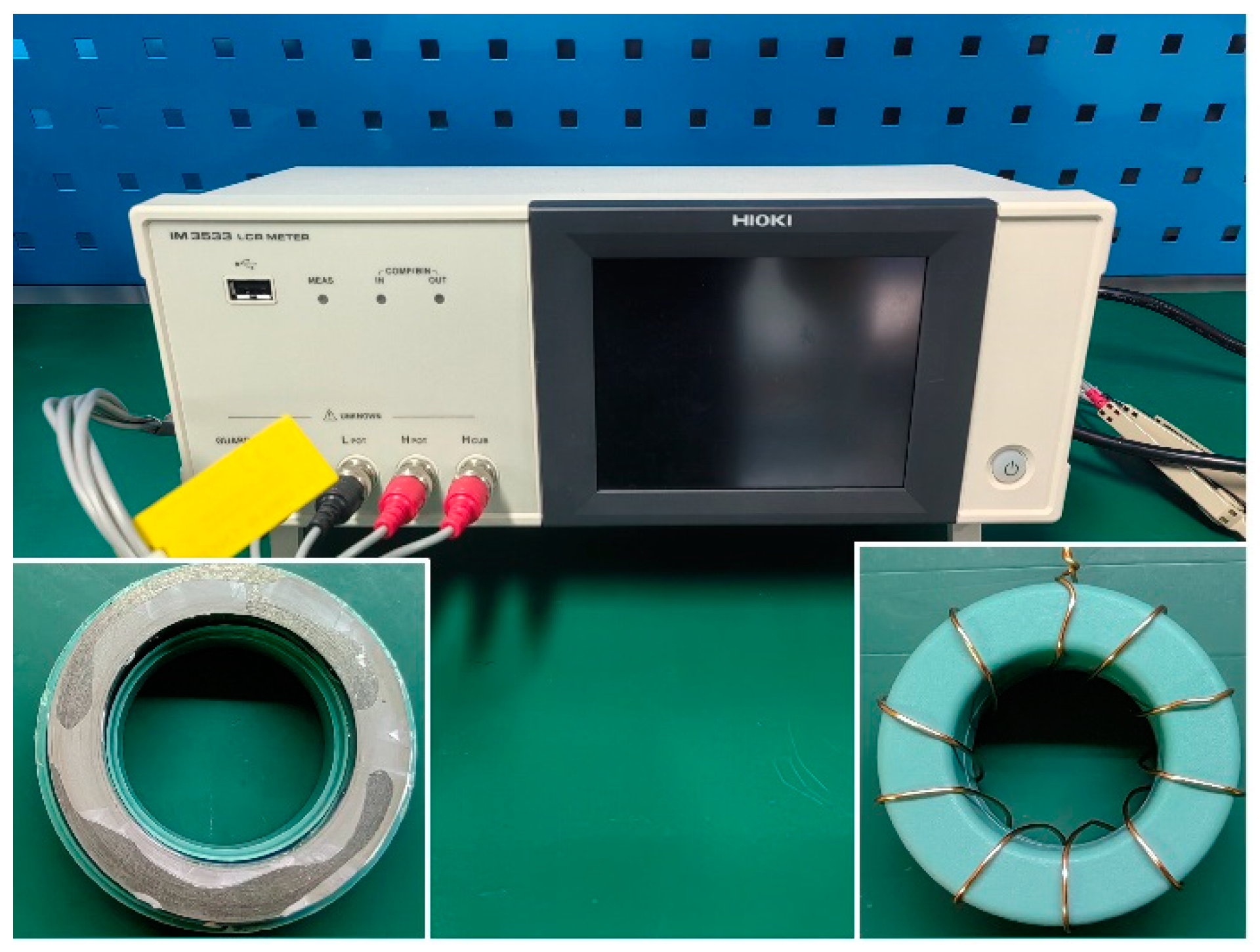
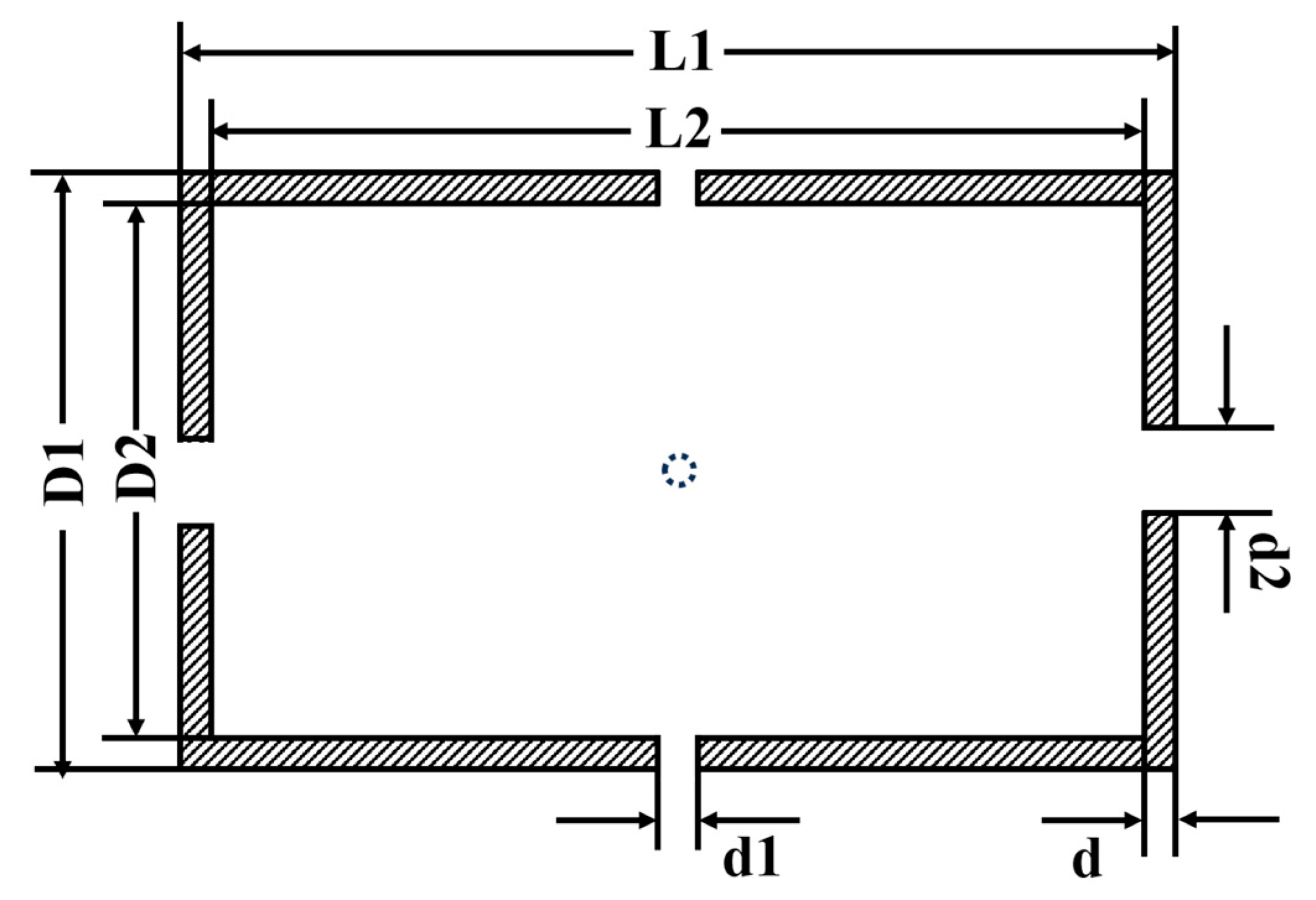

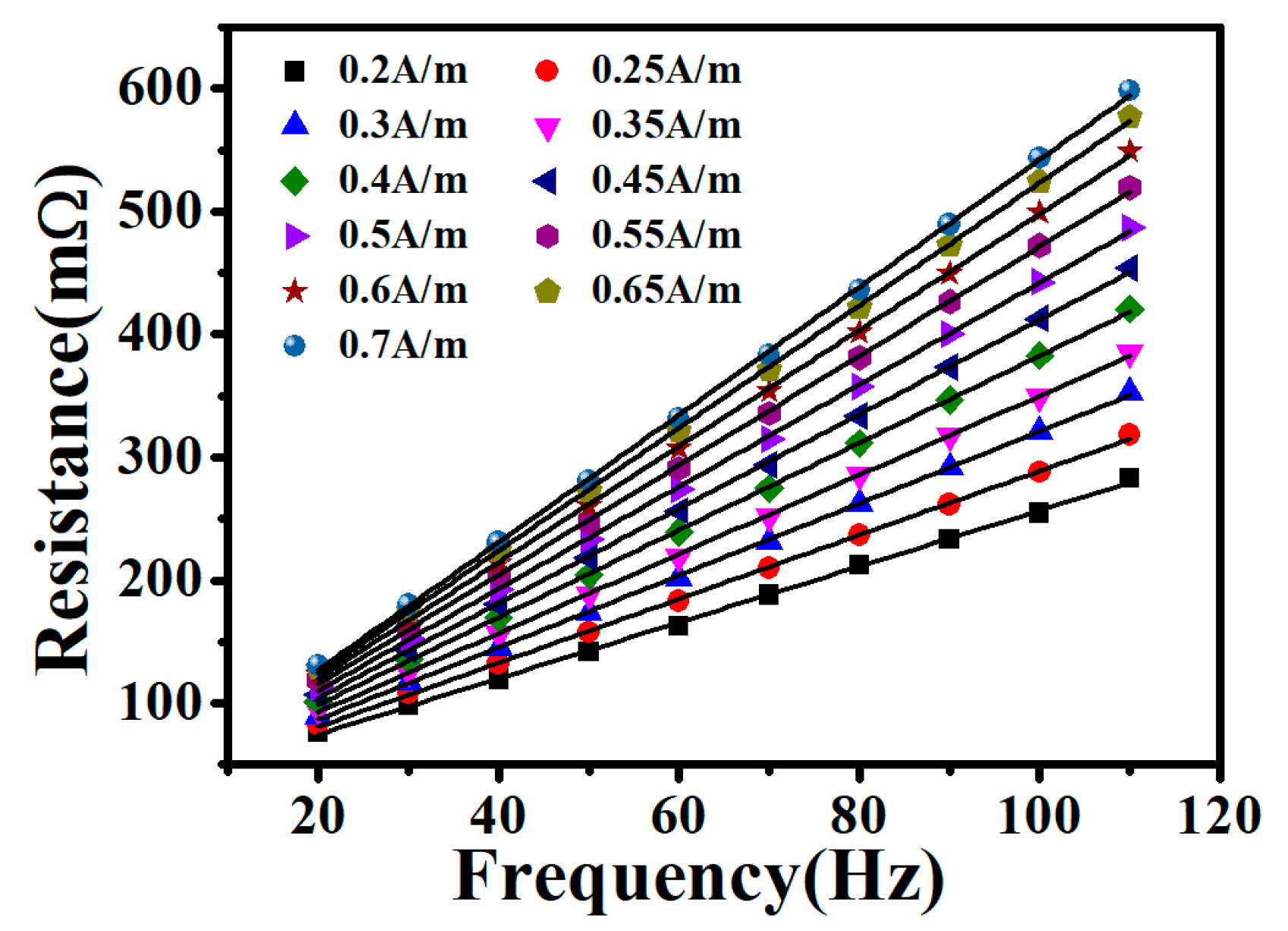
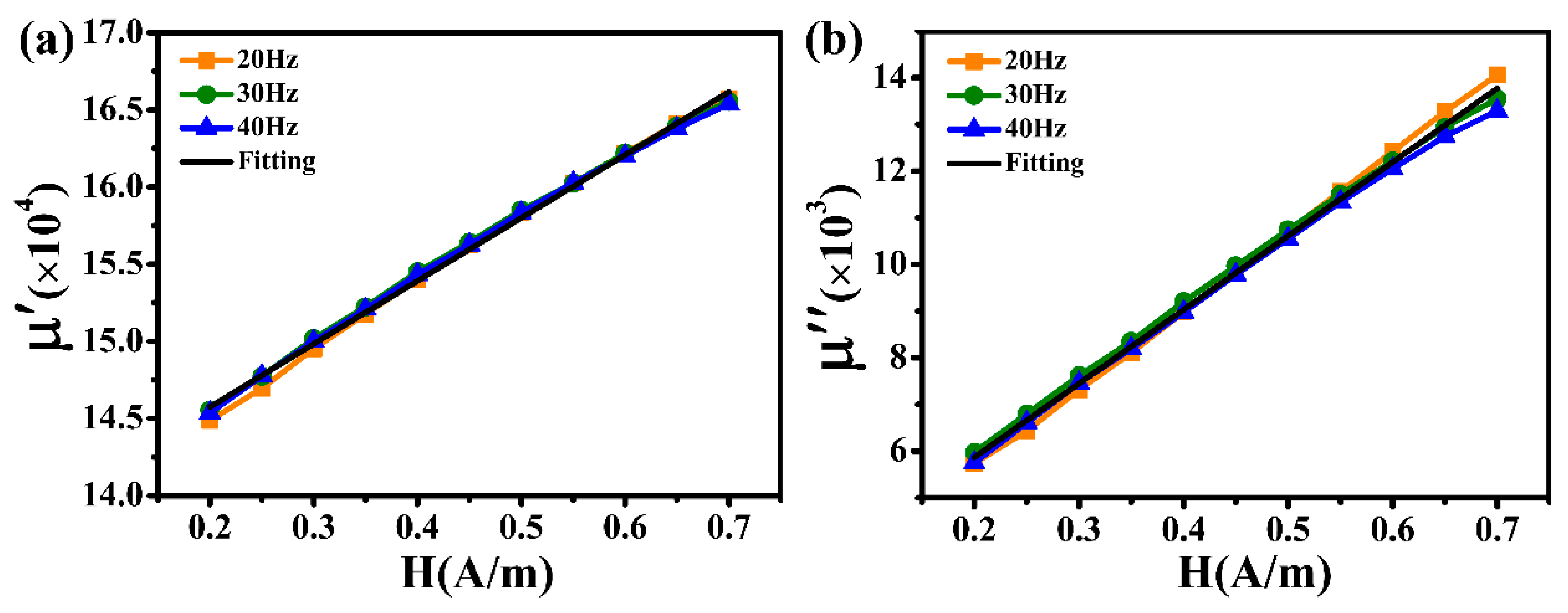

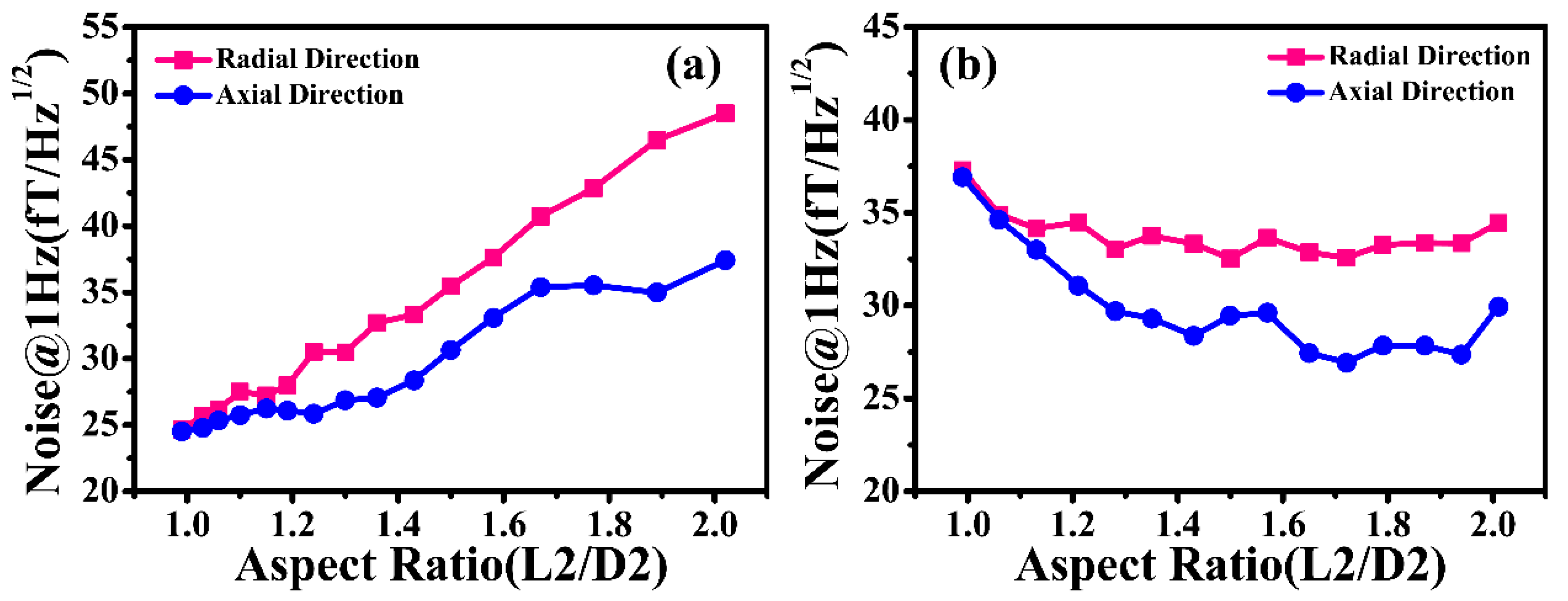
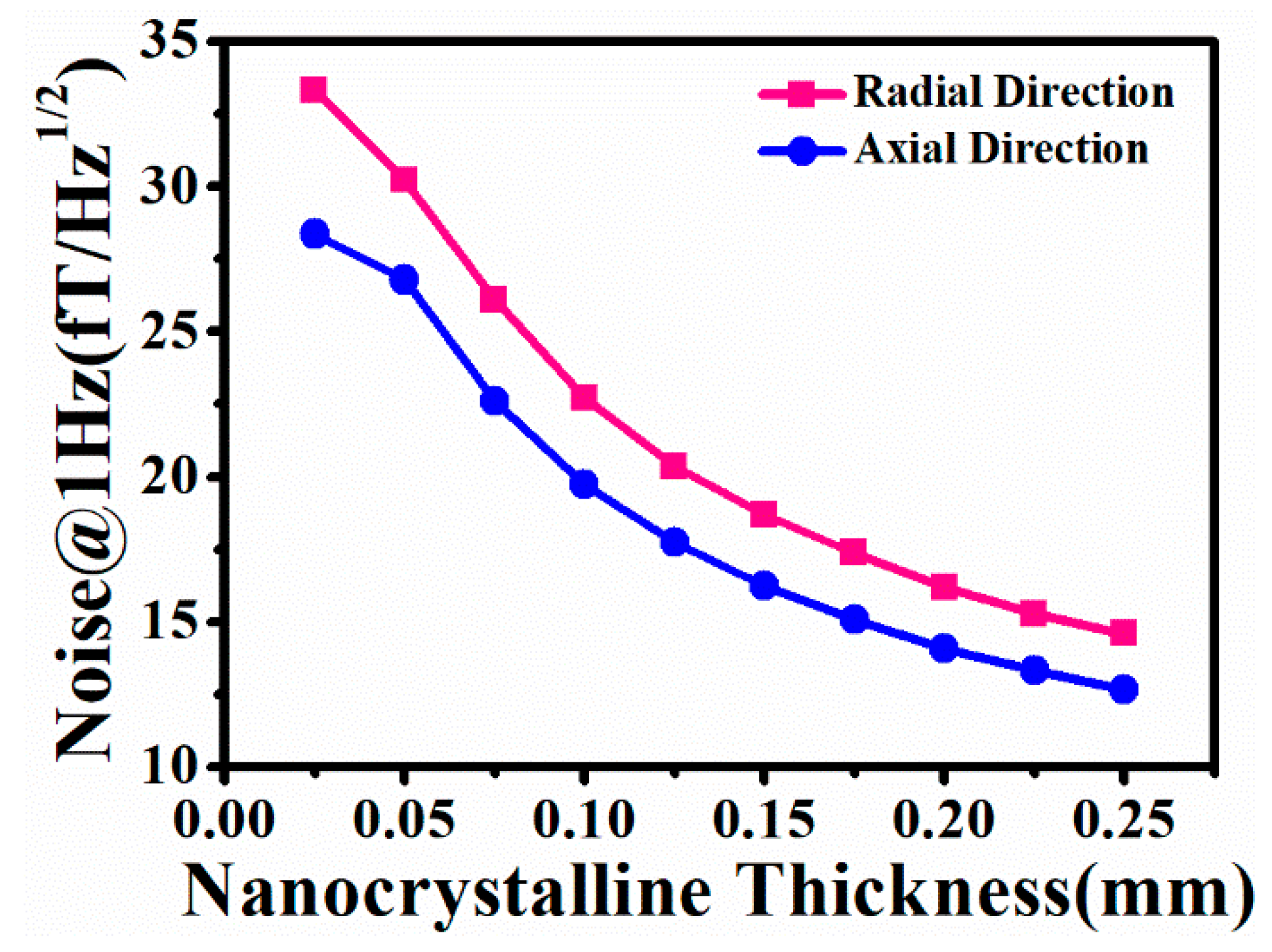
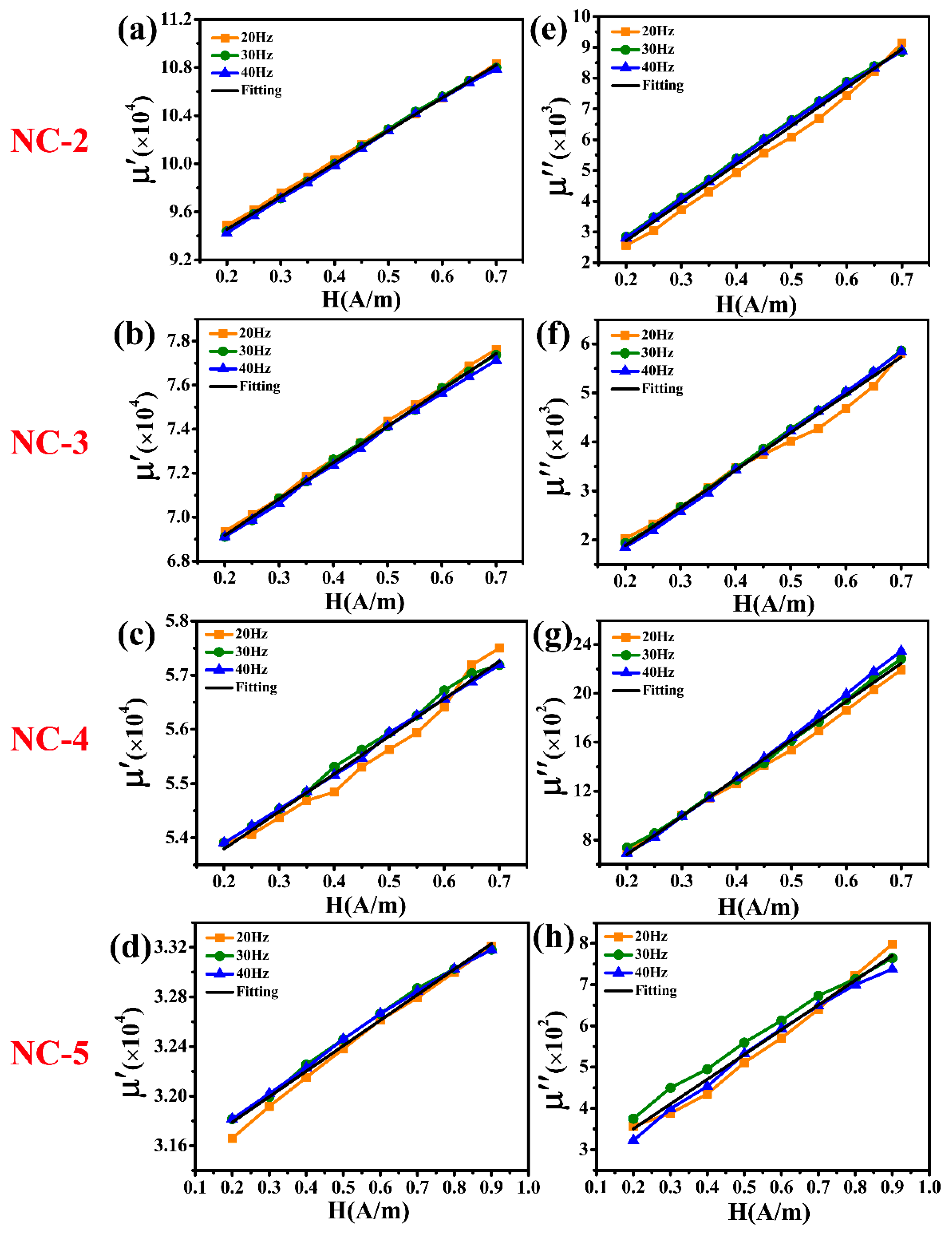
| Parameter Name | Parameter Value |
|---|---|
| Inner length | 117 mm |
| Inner diameter | 82 mm |
| Layer thickness | 0.025 mm |
| Pump hole diameter | 15 mm |
| Probe hole diameter | 8 mm |
| Sample | Lamination Factor (F) | μ′ | μ″ | μ′s | μ″s |
|---|---|---|---|---|---|
| NC-1 | 0.78 | 137,580 | 2702 | 176,385 | 3464 |
| NC-2 | 89,085 | 222 | 114,212 | 285 | |
| NC-3 | 65,877 | 346 | 84,458 | 444 | |
| NC-4 | 0.8 | 52,411 | 55 | 65,514 | 69 |
| NC-5 | 31,378 | 230 | 39,223 | 288 |
| Sample | Radial Magnetic Noise (fT/Hz1/2) | Axial Magnetic Noise (fT/Hz1/2) | Loss Factor α |
|---|---|---|---|
| NC-1 | 33.32 | 28.36 | 1.113 × 10−7 |
| NC-2 | 14.69 | 12.45 | 2.185 × 10−8 |
| NC-3 | 24.71 | 20.87 | 6.224 × 10−8 |
| NC-4 | 13.00 | 11.34 | 1.608 × 10−8 |
| NC-5 | 43.65 | 37.73 | 1.872 × 10−7 |
Disclaimer/Publisher’s Note: The statements, opinions and data contained in all publications are solely those of the individual author(s) and contributor(s) and not of MDPI and/or the editor(s). MDPI and/or the editor(s) disclaim responsibility for any injury to people or property resulting from any ideas, methods, instructions or products referred to in the content. |
© 2025 by the authors. Licensee MDPI, Basel, Switzerland. This article is an open access article distributed under the terms and conditions of the Creative Commons Attribution (CC BY) license (https://creativecommons.org/licenses/by/4.0/).
Share and Cite
Kang, S.; Fan, W.; Lu, J.; Quan, W. Simulation Research on Low-Frequency Magnetic Noise in Fe-Based Nanocrystalline Magnetic Shields. Materials 2025, 18, 330. https://doi.org/10.3390/ma18020330
Kang S, Fan W, Lu J, Quan W. Simulation Research on Low-Frequency Magnetic Noise in Fe-Based Nanocrystalline Magnetic Shields. Materials. 2025; 18(2):330. https://doi.org/10.3390/ma18020330
Chicago/Turabian StyleKang, Shuai, Wenfeng Fan, Jixi Lu, and Wei Quan. 2025. "Simulation Research on Low-Frequency Magnetic Noise in Fe-Based Nanocrystalline Magnetic Shields" Materials 18, no. 2: 330. https://doi.org/10.3390/ma18020330
APA StyleKang, S., Fan, W., Lu, J., & Quan, W. (2025). Simulation Research on Low-Frequency Magnetic Noise in Fe-Based Nanocrystalline Magnetic Shields. Materials, 18(2), 330. https://doi.org/10.3390/ma18020330







